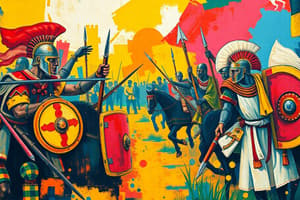Podcast
Questions and Answers
What geographical features characterize Greece?
What geographical features characterize Greece?
- Large forests
- Deserts
- Flat plains
- Mountainous terrain (correct)
What are the primary crops grown in ancient Greece?
What are the primary crops grown in ancient Greece?
Wheat, barley, olives, and grapes.
Why did city-states develop in ancient Greece?
Why did city-states develop in ancient Greece?
- Flat terrain allowed for easy travel
- Mountains made land travel difficult (correct)
- There were no resources to share
- One powerful capital ruled all
When did the Mycenaean civilization dominate the Greek countryside?
When did the Mycenaean civilization dominate the Greek countryside?
What were the main components of a Mycenaean infantryman?
What were the main components of a Mycenaean infantryman?
What marks the Hoplite warfare in the Classical Age?
What marks the Hoplite warfare in the Classical Age?
A phalanx is a line/group of well-armed hoplite soldiers usually ____ to ____ men deep.
A phalanx is a line/group of well-armed hoplite soldiers usually ____ to ____ men deep.
Who laid the foundations for Alexander's army?
Who laid the foundations for Alexander's army?
What was the defining weapon of Alexander's army?
What was the defining weapon of Alexander's army?
Hoplite warfare was characterized by heavily armored infantrymen fighting in open formation.
Hoplite warfare was characterized by heavily armored infantrymen fighting in open formation.
How were soldiers trained during the Archaic period?
How were soldiers trained during the Archaic period?
What influence did Sparta have on military training in the 5th century BC?
What influence did Sparta have on military training in the 5th century BC?
What was a significant change in warfare during ancient Greece?
What was a significant change in warfare during ancient Greece?
Study Notes
Geography of Greece
- Greece is a mountainous nation, surrounded by the Mediterranean Sea, with over 1400 islands.
- Features mild winters and long, hot, dry summers, supporting a seafaring lifestyle.
- Traded extensively with Mediterranean countries; cities established colonies overseas.
- City-states were concentrated in a southern peninsula, with only 20% of the rocky land suitable for farming, relying on imports for staple crops.
Formation of City-States
- Independent city-states arose due to difficult land travel caused by mountains, promoting local power centers.
- Greek cities developed across regions including the Black Sea, North Africa, and southern Europe.
- Greek aristocracy vigorously defended the political independence of their respective city-states.
Hoplite Warfare - Mycenaean Era
- Mycenaean period (c. 1350-1200 BC) marked by heavily fortified citadels with limited access.
- Mycenae and Argos dominated Greek mainland until their decline around 1100 BC.
- Infantryman relied on a spear, large shield, helmet, and a thrusting sword.
- 'Dendra' armor consisted of bronze plates, offering significant close-quarters protection.
Hoplite Warfare - Classical Age
- Classical period (c. 510-323 BC) saw hoplites equipped with long spears, short swords, and bronze shields.
- Close-quarter combat emphasized bravery (Andreia) and excellence (aretē).
- Lighter armor such as leather became popular for greater mobility.
- Emergence of various troop types, including javelin throwers and cavalry, posed threats to traditional hoplites.
Phalanx Formation
- The phalanx was a tight formation of hoplite soldiers, typically eight to twelve men deep, emphasizing coordinated attacks.
Alexander's Army
- Under Philip II, Alexander transformed a weak, undisciplined army into an effective military force.
- Heavy cavalry served as a decisive strike force, while the sarissa, a long pike, was a key weapon.
- Utilized phalanx tactics and combined arms strategy, never losing a battle.
Nature of Hoplite Warfare
- Heavily armored hoplites fought in formation, using their shields to cover themselves and neighboring soldiers.
- Cohesion and protection were crucial to maintaining formation during battle.
Training in the Archaic Period
- Early military training was inconsistent, with soldiers often using makeshift weapons.
- Soldiers received some pay to support their needs; no uniforms were standard.
- Transition back to agricultural work occurred quickly after conflicts ended.
Training from the 5th Century Onwards
- Sparta's military prowess set a benchmark, influencing other states.
- Professional armies emerged, characterized by red cloaks and shields marked with 'lambda' for Lacedaemonians.
- Other city-states began to establish small professional forces to support larger citizen armies, including diverse recruits.
Evolution of Warfare
- Warfare shifted from quick battles to protracted conflicts, notably exemplified by the Persian Wars.
- Long campaigns became more common, changing the nature of Greek military engagements.
Studying That Suits You
Use AI to generate personalized quizzes and flashcards to suit your learning preferences.
Description
Explore the geography of Greece and its impact on ancient warfare through these engaging flashcards. Learn about the mountainous terrain, the extensive coastline, and how these features influenced the seafaring culture and military strategies of the Ancient Greeks. Dive into the world of city-states, trade, and colonization.




